Abstract
1. The present study was designed to determine the effect of sleep on the tonic output to respiratory muscle and on the level of chemical respiratory stimulation required to produce rhythmic respiratory output. 2. Chronically implanted electrodes recorded expiratory (triangularis sterni) and inspiratory (diaphragm and parasternal intercostal) electromyographic (EMG) activities in three trained dogs during wakefulness and sleep. The dogs were mechanically hyperventilated via an endotracheal tube inserted into a permanent tracheostomy. During the studies, a cold block of the cervical vagus nerves was maintained to avoid the complicating effects of vagal inputs on respiratory drive and rhythm. 3. During wakefulness, steady-state hypocapnia (partial pressure of CO2, PCO2 = 30 mmHg) abolished inspiratory EMG activity, resulting in apnoea, but the expiratory muscle became tonically active. Compared to wakefulness, the level of the tonic expiratory EMG activity was decreased in non-REM (non-rapid eye movement) sleep (median decrease = 34%, P = 0.005) and was further decreased in REM sleep (median decrease = 78%, P < 0.0001). During REM sleep, the tonic expiratory EMG activity was highly variable (mean coefficient of variation = 39% compared to 7% awake, P < 0.0001) and in some periods of REM, bursts of inspiratory EMG activity and active breathing movements were observed despite the presence of hypocapnia. 4. During constant mechanical hyperventilation, progressive increases in arterial PCO2 (in hyperoxia) were produced by rebreathing. Measurement of the CO2 threshold for the onset of spontaneous breathing showed that this threshold was not different between wakefulness and non-REM sleep (mean difference = 0.1 mmHg from paired observations, 95% confidence interval for the difference = -1.0 to +1.1 mmHg, P = 0.898). 5. The results show that sleep reduces the tonic output to respiratory muscles but does not increase the CO2 threshold for the generation of rhythmic respiratory output. These observations suggest that changes in the tonic drives to the respiratory motoneurones may be a principal mechanism by which changes in sleep-wake states produce changes in respiratory output.
Full text
PDF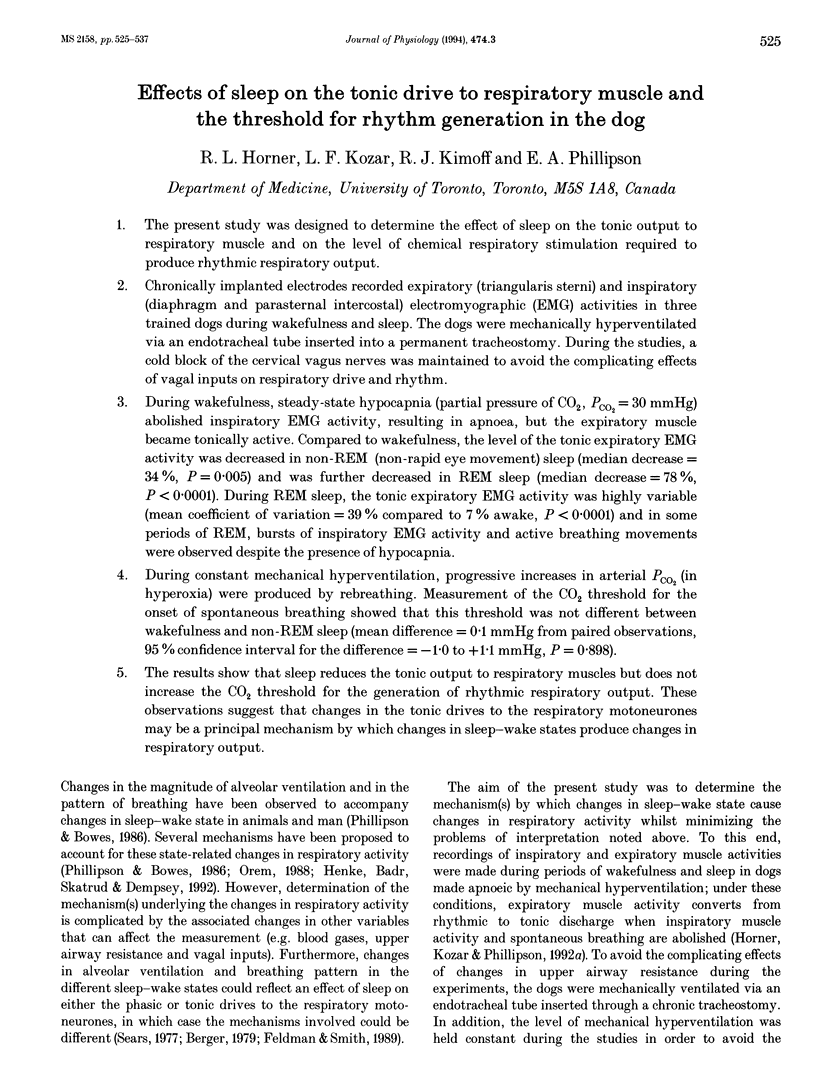
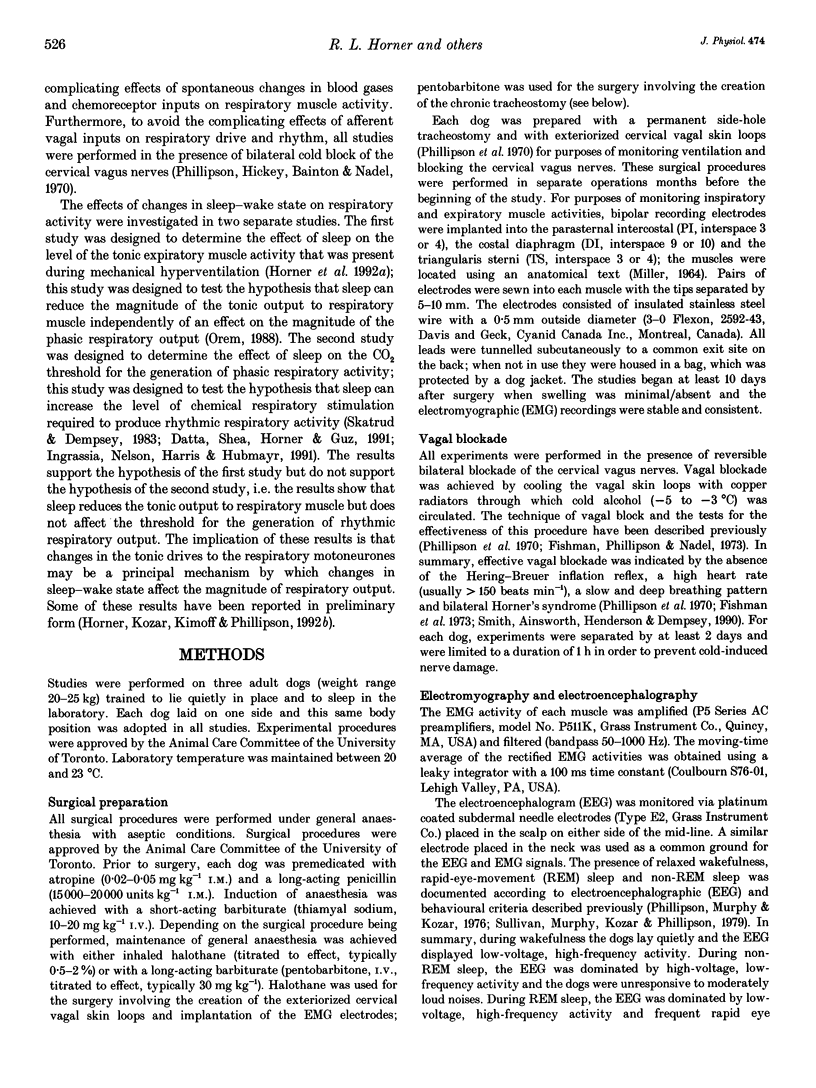
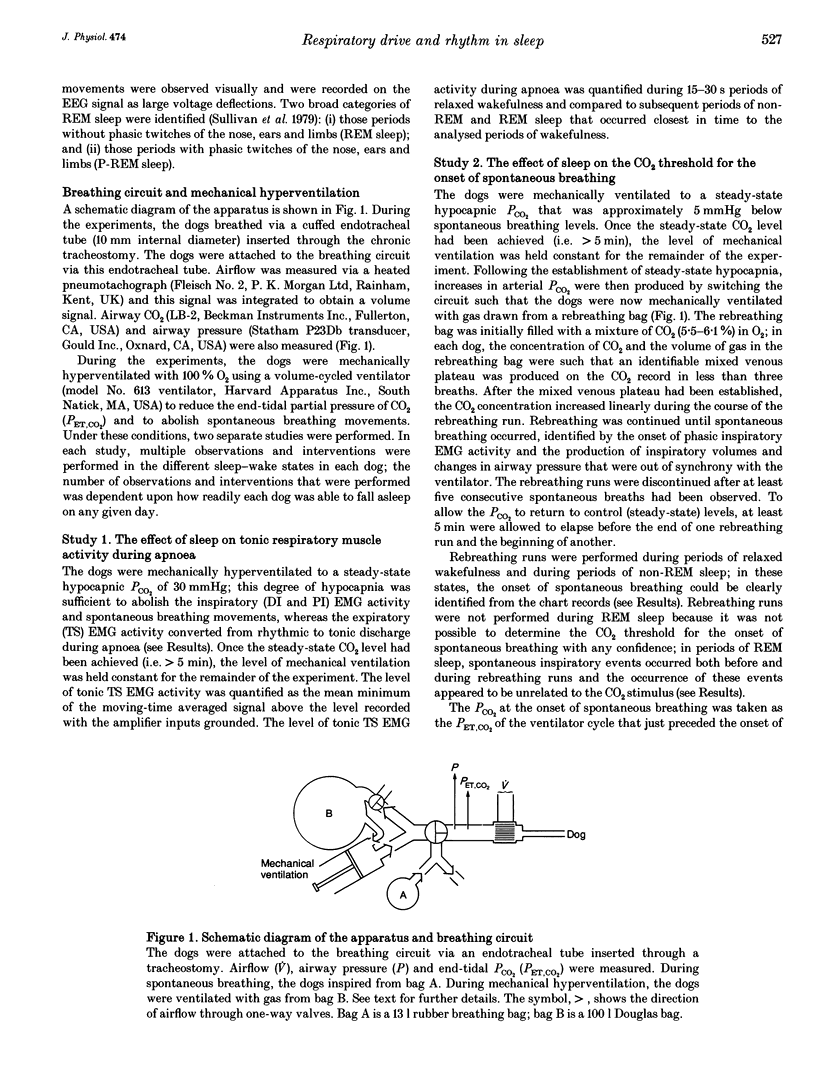
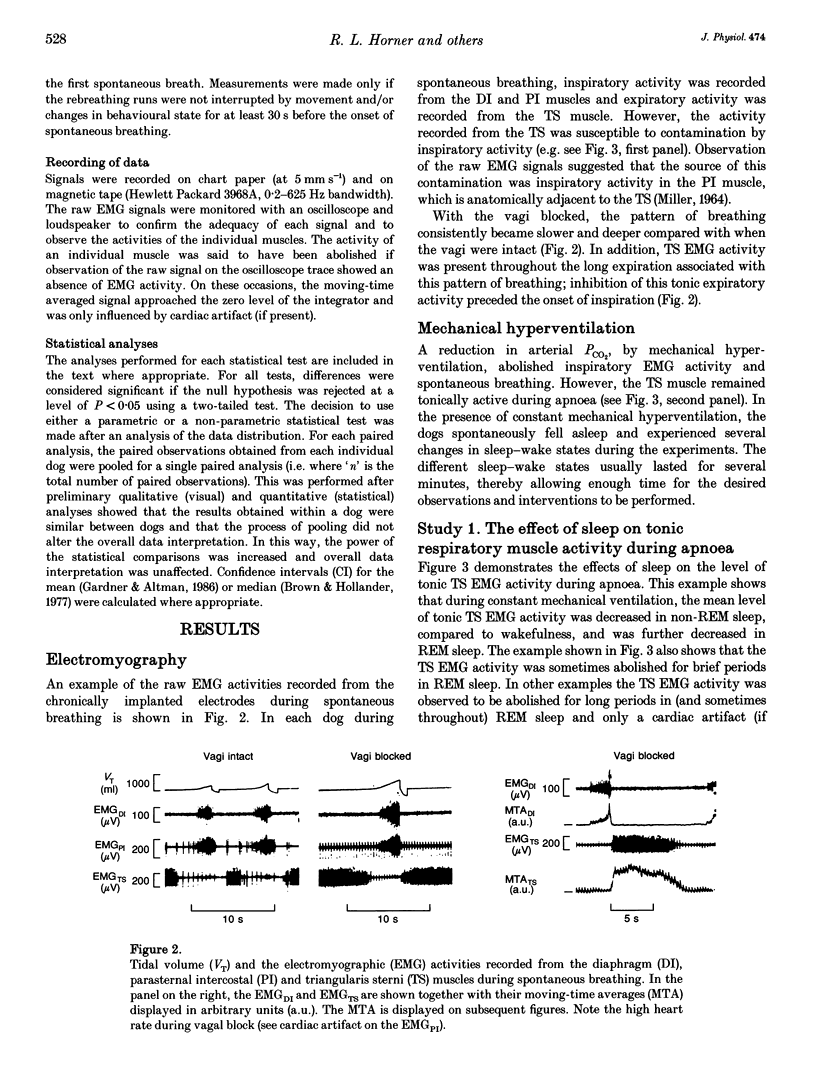
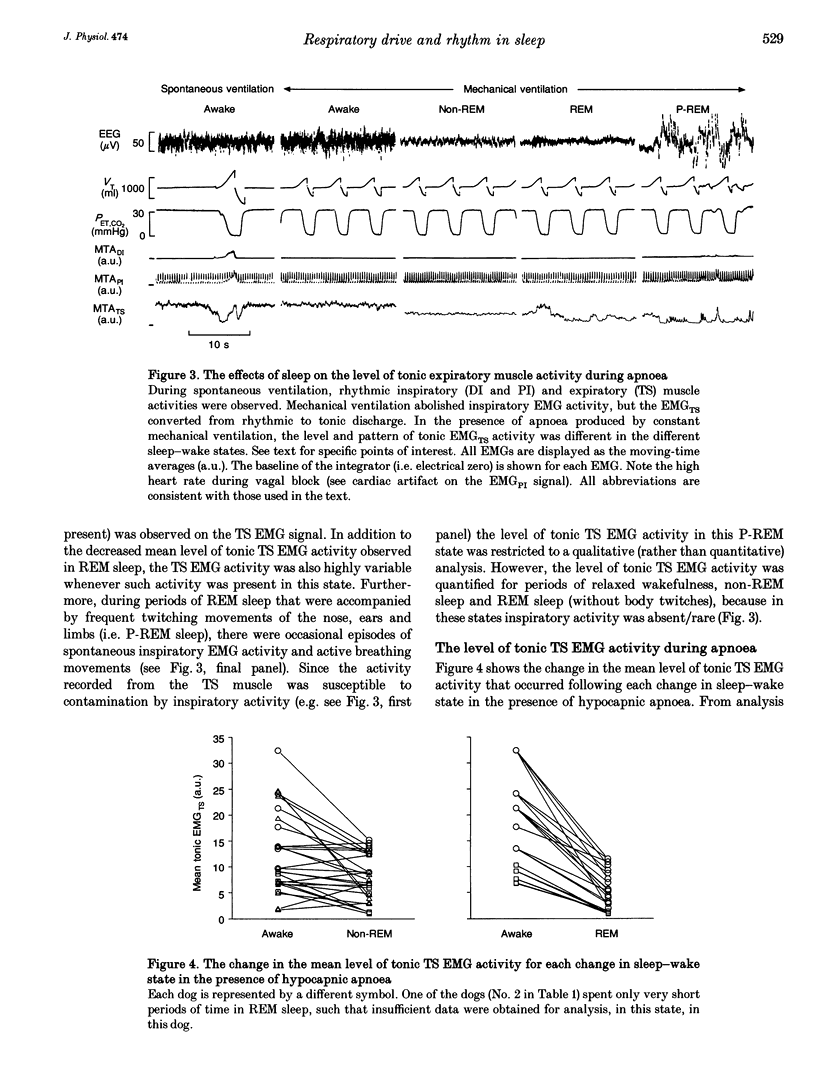
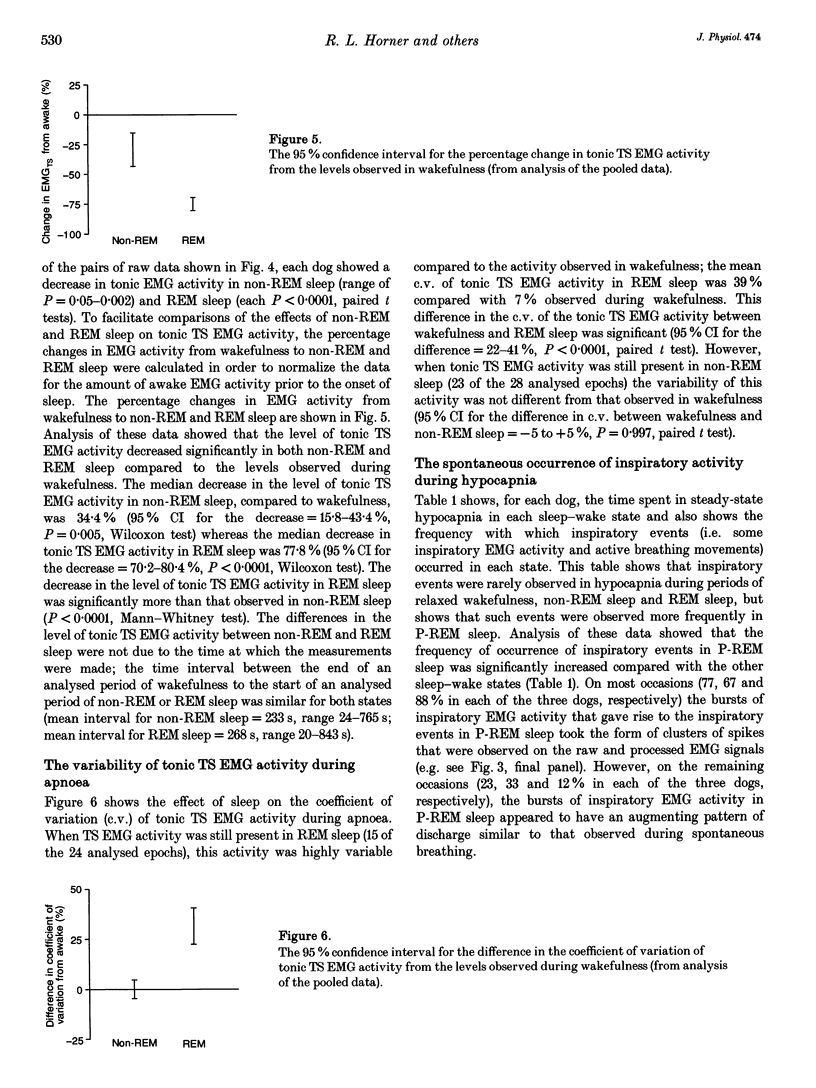
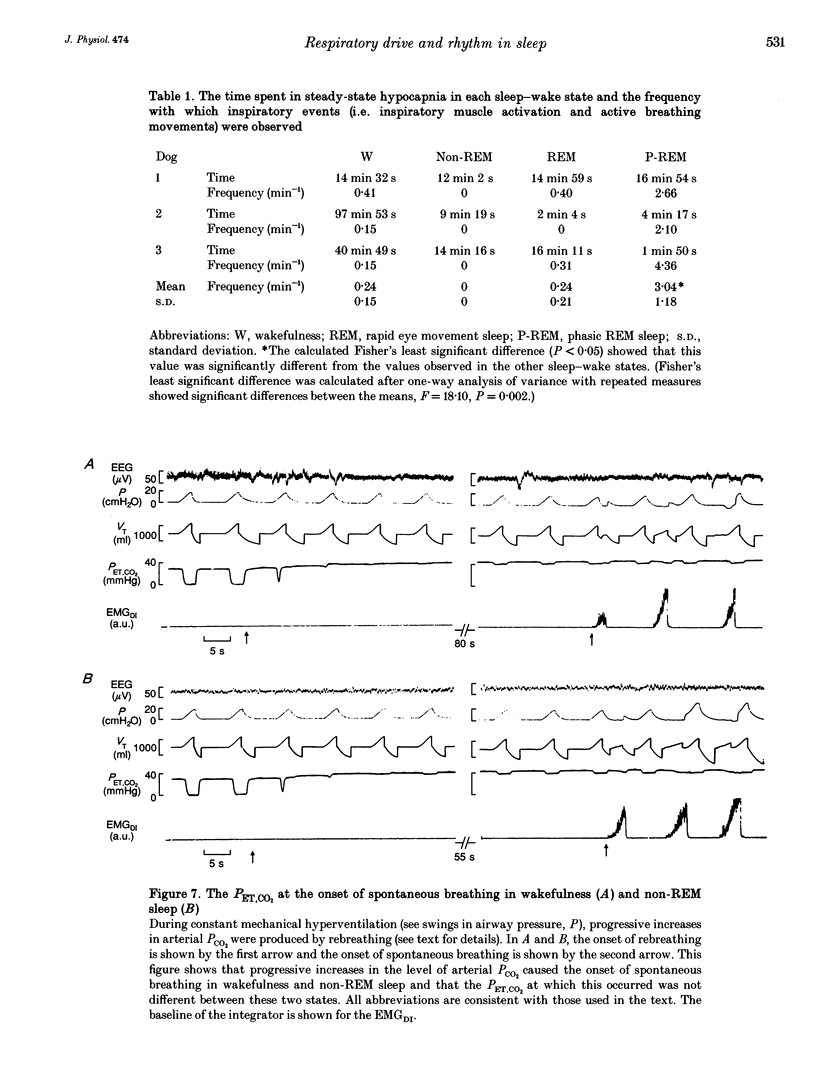
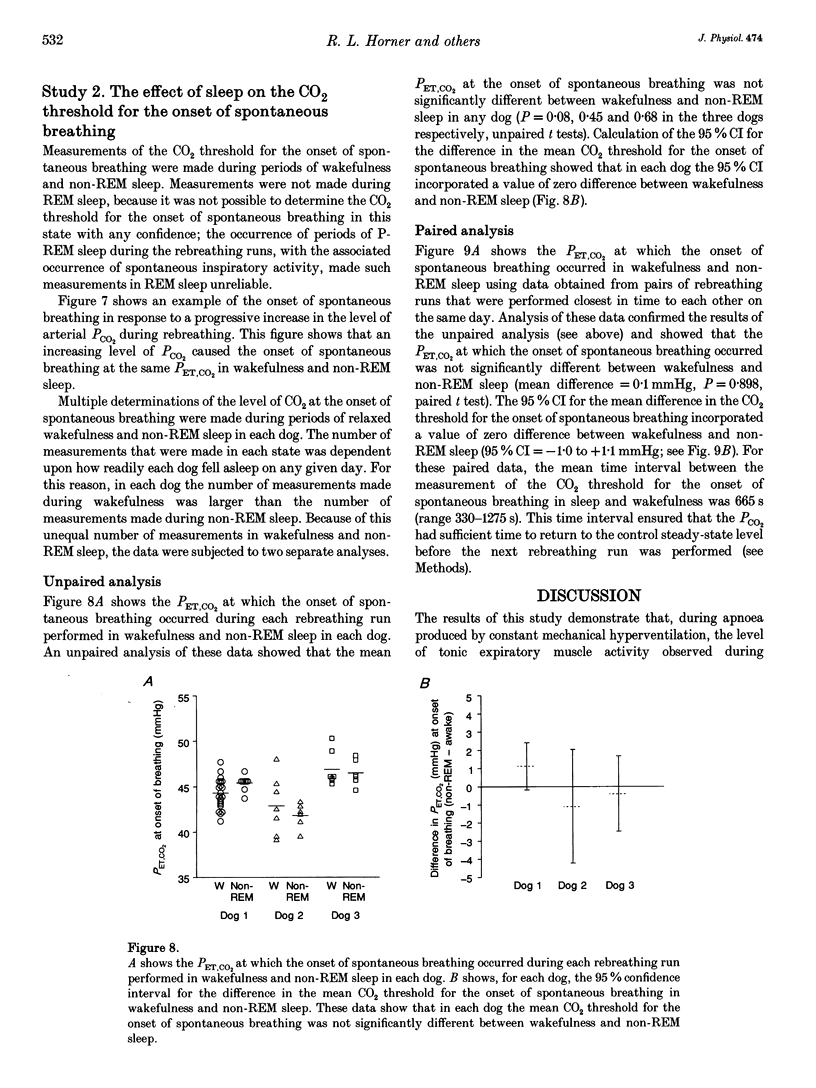
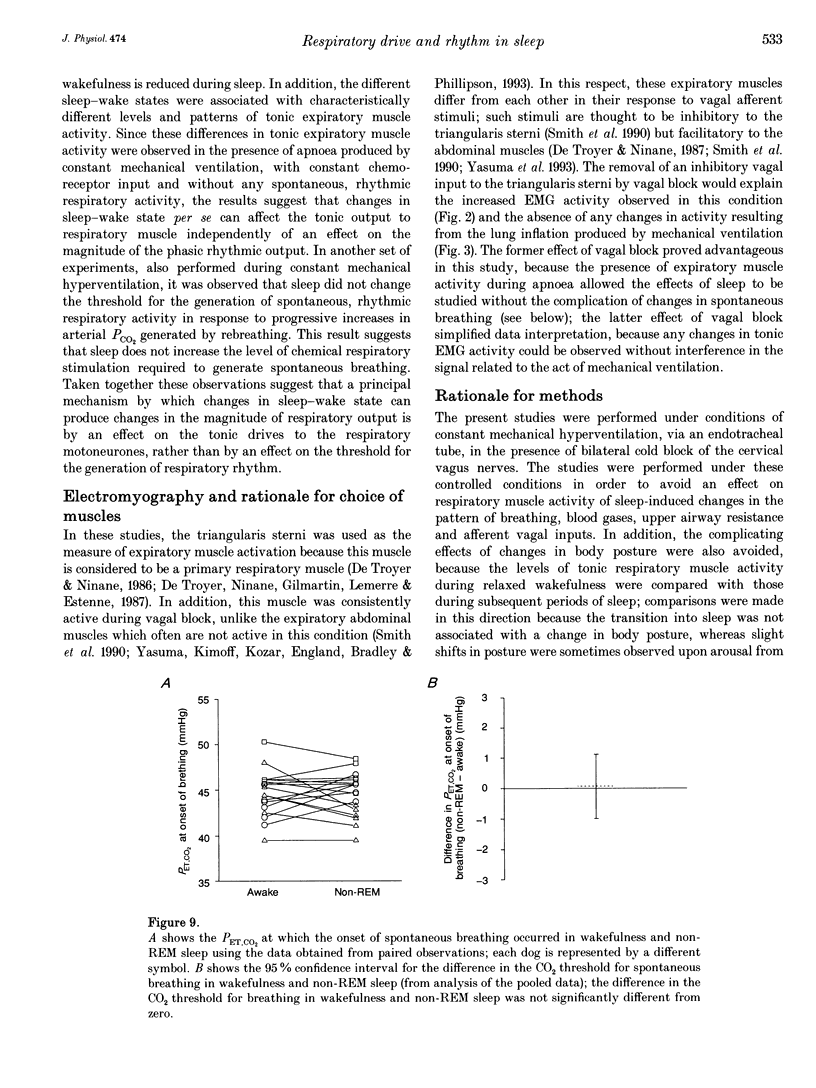
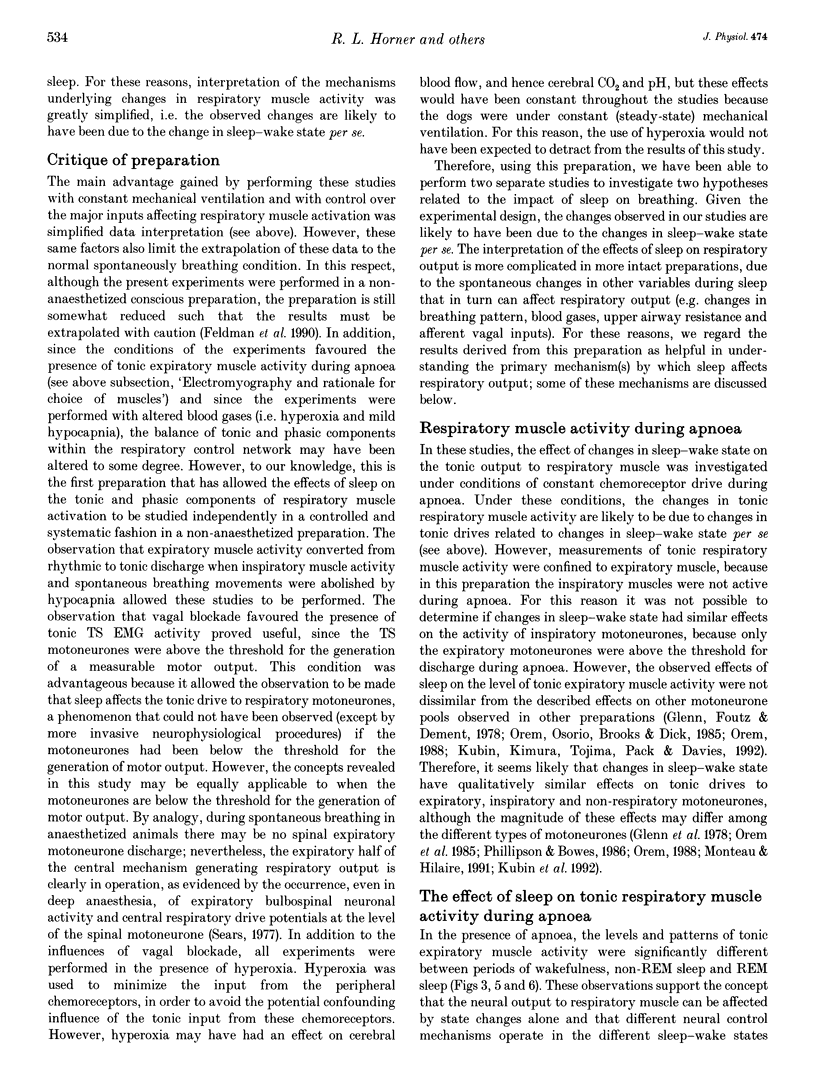
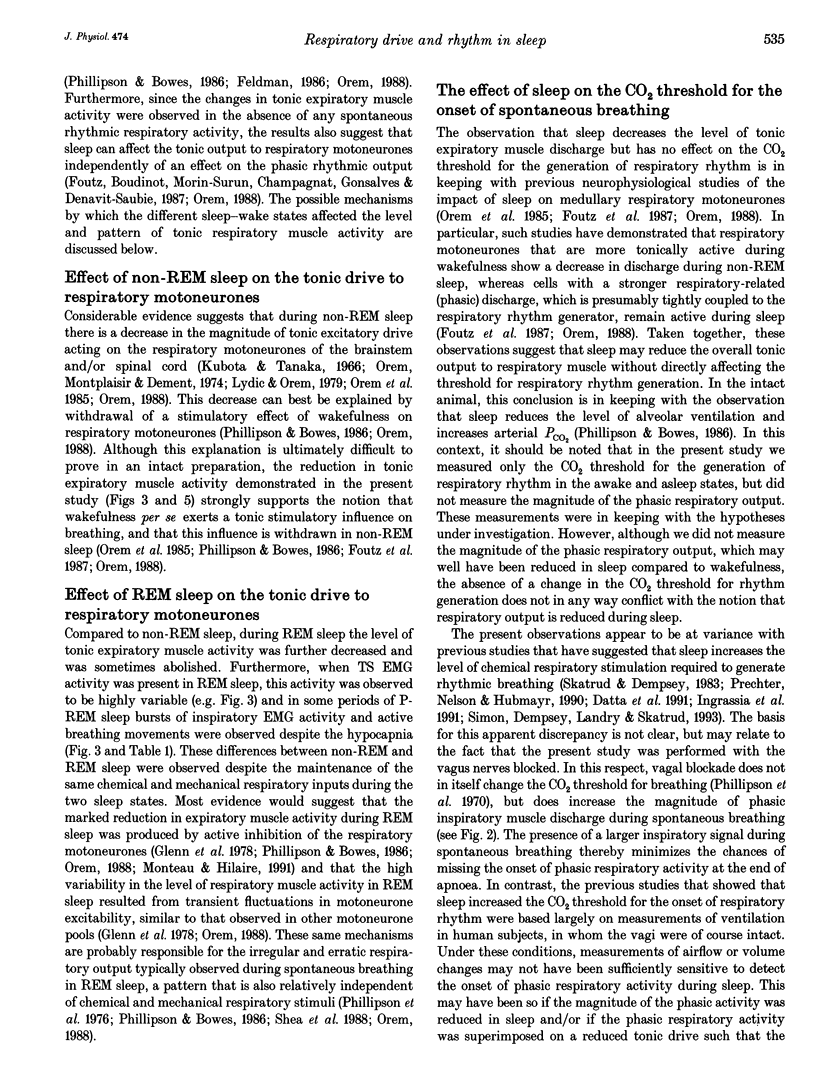
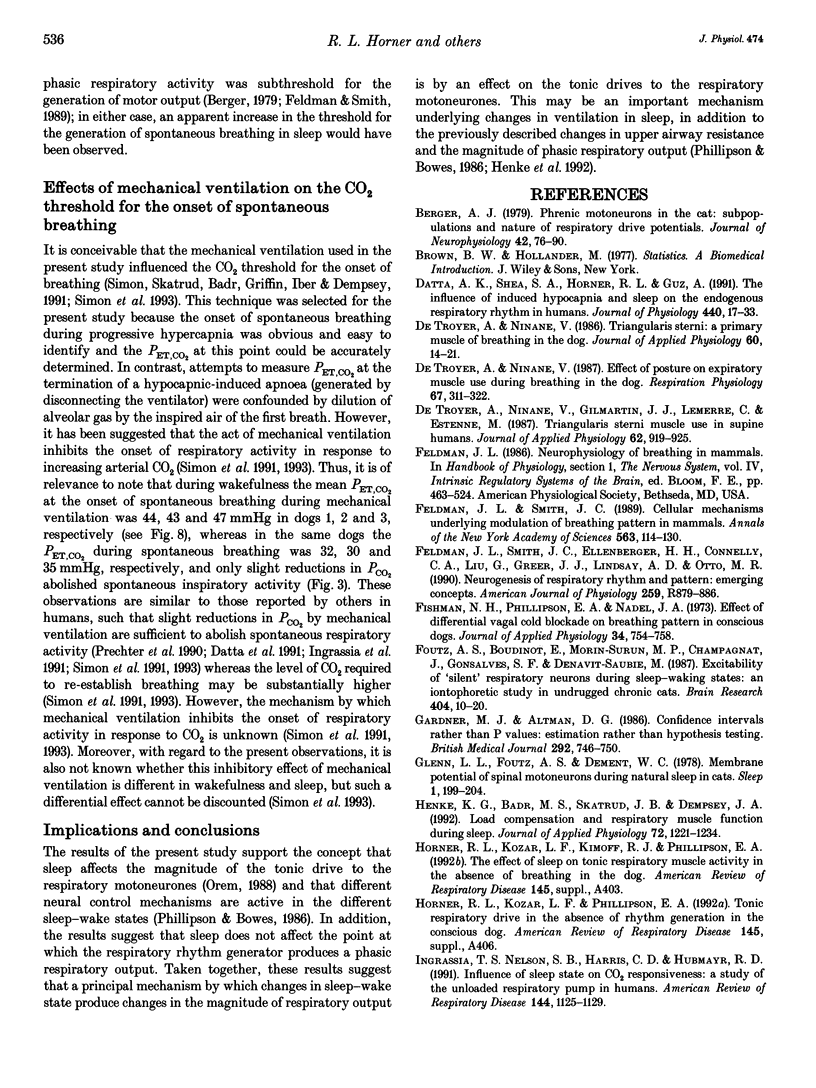
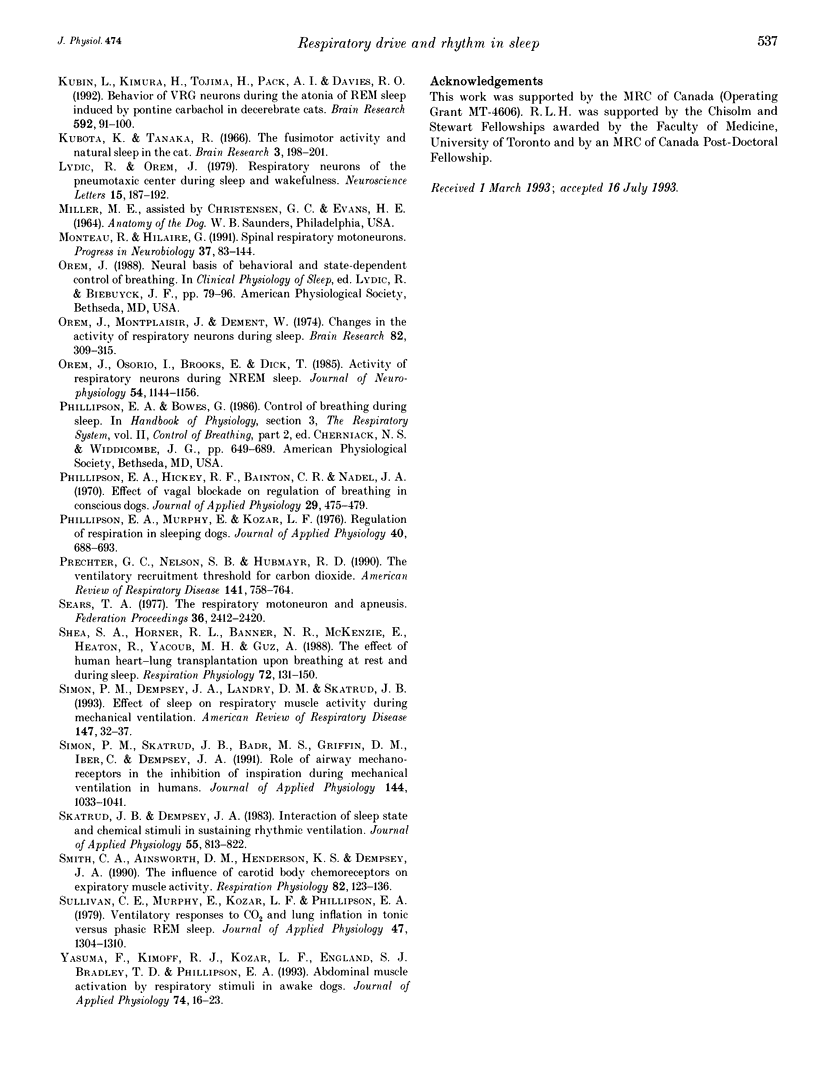
Selected References
These references are in PubMed. This may not be the complete list of references from this article.
- Berger A. J. Phrenic motoneurons in the cat: subpopulations and nature of respiratory drive potentials. J Neurophysiol. 1979 Jan;42(1 Pt 1):76–90. doi: 10.1152/jn.1979.42.1.76. [DOI] [PubMed] [Google Scholar]
- Datta A. K., Shea S. A., Horner R. L., Guz A. The influence of induced hypocapnia and sleep on the endogenous respiratory rhythm in humans. J Physiol. 1991;440:17–33. doi: 10.1113/jphysiol.1991.sp018693. [DOI] [PMC free article] [PubMed] [Google Scholar]
- De Troyer A., Ninane V. Effect of posture on expiratory muscle use during breathing in the dog. Respir Physiol. 1987 Mar;67(3):311–322. doi: 10.1016/0034-5687(87)90061-2. [DOI] [PubMed] [Google Scholar]
- De Troyer A., Ninane V., Gilmartin J. J., Lemerre C., Estenne M. Triangularis sterni muscle use in supine humans. J Appl Physiol (1985) 1987 Mar;62(3):919–925. doi: 10.1152/jappl.1987.62.3.919. [DOI] [PubMed] [Google Scholar]
- De Troyer A., Ninane V. Triangularis sterni: a primary muscle of breathing in the dog. J Appl Physiol (1985) 1986 Jan;60(1):14–21. doi: 10.1152/jappl.1986.60.1.14. [DOI] [PubMed] [Google Scholar]
- Feldman J. L., Smith J. C. Cellular mechanisms underlying modulation of breathing pattern in mammals. Ann N Y Acad Sci. 1989;563:114–130. doi: 10.1111/j.1749-6632.1989.tb42194.x. [DOI] [PubMed] [Google Scholar]
- Feldman J. L., Smith J. C., Ellenberger H. H., Connelly C. A., Liu G. S., Greer J. J., Lindsay A. D., Otto M. R. Neurogenesis of respiratory rhythm and pattern: emerging concepts. Am J Physiol. 1990 Nov;259(5 Pt 2):R879–R886. doi: 10.1152/ajpregu.1990.259.5.R879. [DOI] [PubMed] [Google Scholar]
- Fishman N. H., Phillipson E. A., Nadel J. A. Effect of differential vagal cold blockade on breathing pattern in conscious dogs. J Appl Physiol. 1973 Jun;34(6):754–758. doi: 10.1152/jappl.1973.34.6.754. [DOI] [PubMed] [Google Scholar]
- Foutz A. S., Boudinot E., Morin-Surun M. P., Champagnat J., Gonsalves S. F., Denavit-Saubié M. Excitability of 'silent' respiratory neurons during sleep-waking states: an iontophoretic study in undrugged chronic cats. Brain Res. 1987 Feb 24;404(1-2):10–20. doi: 10.1016/0006-8993(87)91350-3. [DOI] [PubMed] [Google Scholar]
- Gardner M. J., Altman D. G. Confidence intervals rather than P values: estimation rather than hypothesis testing. Br Med J (Clin Res Ed) 1986 Mar 15;292(6522):746–750. doi: 10.1136/bmj.292.6522.746. [DOI] [PMC free article] [PubMed] [Google Scholar]
- Glenn L. L., Foutz A. S., Dement W. C. Membrane potential of spinal motoneurons during natural sleep in cats. Sleep. 1978 Winter;1(2):199–204. [PubMed] [Google Scholar]
- Henke K. G., Badr M. S., Skatrud J. B., Dempsey J. A. Load compensation and respiratory muscle function during sleep. J Appl Physiol (1985) 1992 Apr;72(4):1221–1234. doi: 10.1152/jappl.1992.72.4.1221. [DOI] [PubMed] [Google Scholar]
- Ingrassia T. S., 3rd, Nelson S. B., Harris C. D., Hubmayr R. D. Influence of sleep state on CO2 responsiveness. A study of the unloaded respiratory pump in humans. Am Rev Respir Dis. 1991 Nov;144(5):1125–1129. doi: 10.1164/ajrccm/144.5.1125. [DOI] [PubMed] [Google Scholar]
- Kubin L., Kimura H., Tojima H., Pack A. I., Davies R. O. Behavior of VRG neurons during the atonia of REM sleep induced by pontine carbachol in decerebrate cats. Brain Res. 1992 Oct 2;592(1-2):91–100. doi: 10.1016/0006-8993(92)91662-x. [DOI] [PubMed] [Google Scholar]
- Kubota K., Tanaka R. The fusimotor activity and natural sleep in the cat. Brain Res. 1966 Dec;3(2):198–201. doi: 10.1016/0006-8993(66)90078-3. [DOI] [PubMed] [Google Scholar]
- Lydic R., Orem J. Respiratory neurons of the pneumotaxic center during sleep and wakefulness. Neurosci Lett. 1979 Dec;15(2-3):187–192. doi: 10.1016/0304-3940(79)96111-1. [DOI] [PubMed] [Google Scholar]
- Monteau R., Hilaire G. Spinal respiratory motoneurons. Prog Neurobiol. 1991;37(2):83–144. doi: 10.1016/0301-0082(91)90024-u. [DOI] [PubMed] [Google Scholar]
- Orem J., Montplaisir J., Dement W. C. Changes in the activity of respiratory neurons during sleep. Brain Res. 1974 Dec 27;82(2):309–315. doi: 10.1016/0006-8993(74)90611-8. [DOI] [PubMed] [Google Scholar]
- Orem J., Osorio I., Brooks E., Dick T. Activity of respiratory neurons during NREM sleep. J Neurophysiol. 1985 Nov;54(5):1144–1156. doi: 10.1152/jn.1985.54.5.1144. [DOI] [PubMed] [Google Scholar]
- Phillipson E. A., Hickey R. F., Bainton C. R., Nadel J. A. Effect of vagal blockade on regulation of breathing in conscious dogs. J Appl Physiol. 1970 Oct;29(4):475–479. doi: 10.1152/jappl.1970.29.4.475. [DOI] [PubMed] [Google Scholar]
- Phillipson E. A., Murphy E., Kozar L. F. Regulation of respiration in sleeping dogs. J Appl Physiol. 1976 May;40(5):688–693. doi: 10.1152/jappl.1976.40.5.688. [DOI] [PubMed] [Google Scholar]
- Prechter G. C., Nelson S. B., Hubmayr R. D. The ventilatory recruitment threshold for carbon dioxide. Am Rev Respir Dis. 1990 Mar;141(3):758–764. doi: 10.1164/ajrccm/141.3.758. [DOI] [PubMed] [Google Scholar]
- Sears T. A. The respiratory motoneuron and apneusis. Fed Proc. 1977 Sep;36(10):2412–2420. [PubMed] [Google Scholar]
- Shea S. A., Horner R. L., Banner N. R., McKenzie E., Heaton R., Yacoub M. H., Guz A. The effect of human heart-lung transplantation upon breathing at rest and during sleep. Respir Physiol. 1988 May;72(2):131–149. doi: 10.1016/0034-5687(88)90001-1. [DOI] [PubMed] [Google Scholar]
- Simon P. M., Dempsey J. A., Landry D. M., Skatrud J. B. Effect of sleep on respiratory muscle activity during mechanical ventilation. Am Rev Respir Dis. 1993 Jan;147(1):32–37. doi: 10.1164/ajrccm/147.1.32. [DOI] [PubMed] [Google Scholar]
- Simon P. M., Skatrud J. B., Badr M. S., Griffin D. M., Iber C., Dempsey J. A. Role of airway mechanoreceptors in the inhibition of inspiration during mechanical ventilation in humans. Am Rev Respir Dis. 1991 Nov;144(5):1033–1041. doi: 10.1164/ajrccm/144.5.1033. [DOI] [PubMed] [Google Scholar]
- Skatrud J. B., Dempsey J. A. Interaction of sleep state and chemical stimuli in sustaining rhythmic ventilation. J Appl Physiol Respir Environ Exerc Physiol. 1983 Sep;55(3):813–822. doi: 10.1152/jappl.1983.55.3.813. [DOI] [PubMed] [Google Scholar]
- Smith C. A., Ainsworth D. M., Henderson K. S., Dempsey J. A. The influence of carotid body chemoreceptors on expiratory muscle activity. Respir Physiol. 1990 Oct;82(1):123–136. doi: 10.1016/0034-5687(90)90029-x. [DOI] [PubMed] [Google Scholar]
- Sullivan C. E., Murphy E., Kozar L. F., Phillipson E. A. Ventilatory responses to CO2 and lung inflation in tonic versus phasic REM sleep. J Appl Physiol Respir Environ Exerc Physiol. 1979 Dec;47(6):1305–1310. doi: 10.1152/jappl.1979.47.6.1304. [DOI] [PubMed] [Google Scholar]
- Yasuma F., Kimoff R. J., Kozar L. F., England S. J., Bradley T. D., Phillipson E. A. Abdominal muscle activation by respiratory stimuli in conscious dogs. J Appl Physiol (1985) 1993 Jan;74(1):16–23. doi: 10.1152/jappl.1993.74.1.16. [DOI] [PubMed] [Google Scholar]


